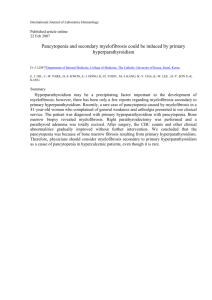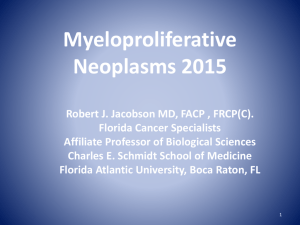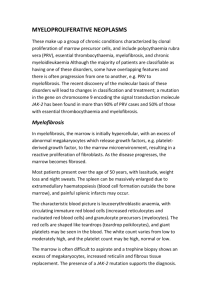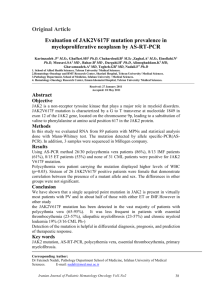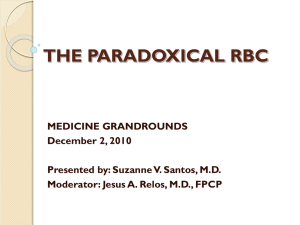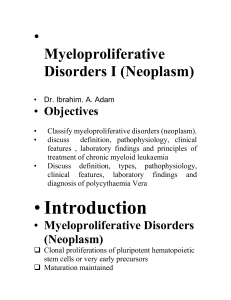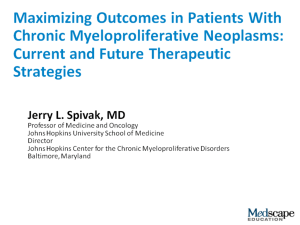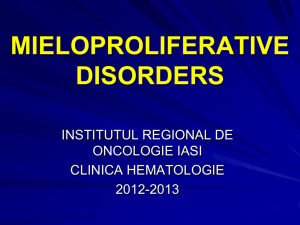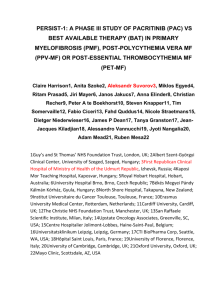PRZEWLEKŁE ZESPOŁY MIELOPROLIFERACYJNE
advertisement
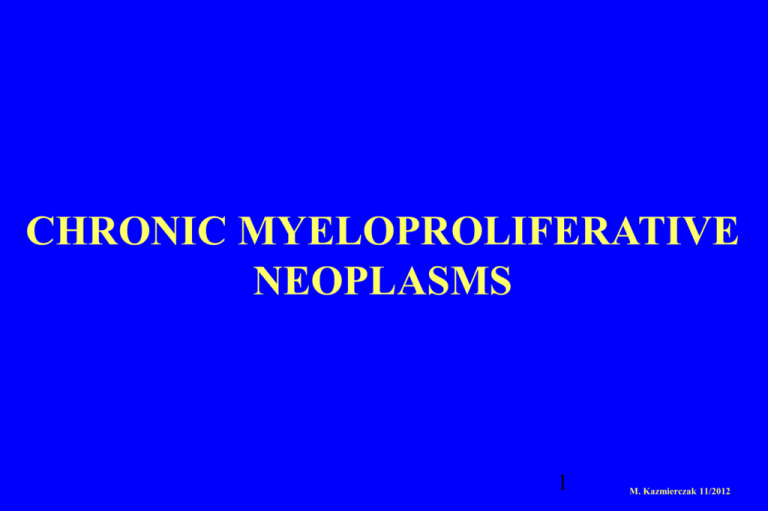
CHRONIC MYELOPROLIFERATIVE NEOPLASMS 1 M. Kazmierczak 11/2012 CHRONIC MYELOPROLIFERATIVE NEOPLASMS (MPN) 1. Polycythemia vera 2. Chronic myeloid leukaemia 3. Essential thrombocythemia 4. Idiopathic myelofibrosis 5.Chronic neutrophilic leukemia 6. Chronic eosinophilic leukemia/hypereosinophilic syndrome 2 CHRONIC MYELOPROLIFERATIVE NEOPLASMS (MPN) MPN are clonal diseases originating in pluripotential haematopoietic stem cell. The clonal expansion results in increased and abnormal haematopoiesis and produces a group of interrelated syndromes, classified according to the predominant phenotypic expression of the myeloproliferative clone. 3 ERYTHROCYTOSIS (Classification) (1) I. Absolute erythrocytosis (Polycythemia): A. Secondary erythrocytosis (abnormal increase of serum erythropoietin level) 1. Erythrocytosis secondary to decreased tissue oxygenation: a) chronic lung diseases b) cyanotic congenital heart diseases c) high-altitude erythrocytosis (Monge disease) d) hypoventilation syndromes (Sleep apnoe) e) hemoglobin-oxygen dissociation abnormalities - hemoglobinopathies associated with high oxygen affinity - carboxyhemoglobin in „smoker’s polycythemia” 4 ERYTHROCYTOSIS (Classification) (2) I. Absolute erythrocytosis (Polycythemia): A. Secondary erythrocytosis (abnormal increase of serum erythropoietin level) 2. Secondary to aberrant erythropoietin production or response: a) Erythropoietin-producting tumors: hepatoma, uterine leiomyoma, cerebellar hemangioblastoma, ovarian carcinoma, pheochromocytoma b) Renal diseases: renal cell carcinoma, kidney cysts and hydronephrosis, renal transplantation. c) Androgen abuse: adrenal cortical hypersecretion, exogenous androgens B. Primery erythrocytosis 1. Polycythemia vera 2. Familial erythrocytosis II. Relative erythrocytosis (pseudopolycythemia): 1. Hemoconcentration 2. Spurious polycythemia (Gaisboek syndrome) 5 POLYCYTHEMIA VERA (PV) Patogenesis PV is a clonal disorder involving the hematopoietic stem cells; it leads to an autonomous proliferation of the erythroid, myeloid, and megakaryocytic cell lines. Increased erythroid proliferation is usually more prominent than that of the other cell lines and occurs independently of erythropoietin levels (which are usually very low in PV) Epidemiology The incidence rate of PV is approximately 2 per 100.000 population. PV is slightly more prevalent in males with male/female ratio ranging from 1,2 to 2:1. Median age at diagnosis was 60 years in men and 62 years in women. 6 POLYCYTHEMIA VERA symptoms 1. Erythrocytosis and hyperviscosity, leading to impaired oxygen delivery: • Poor CNS circulation: headaches, dizziness, vertigo, tinnitus and visual disturbances • Poor coronary circulation: angina pectoris • Peripheral circulation intermittent claudication 2. Venous thrombosis or thromboembolism 3. Hemorrhage: epistaxis, gingival bleeding, ecchymoses, gastrointestinal bleedin 4. Abdominal pain secondary to peptic ulcer 5. Early satiety due to splenomegaly 6. Pruritus is secondary to increased histamine release from the basophils and mast cells 7 POLYCYTHEMIA VERA physical examination 1. Splenomegaly – is present in 75% of patients at the time of diagnosis. 2. Hepatomegaly - is present in approximately 30% of patients at the time of diagnosis. 3. Hypertension 4. On examination of the eye grounds, the vessels may be engorged, tortuous, and irregular in diameter; the veins may be dark purple.( fundus policythaemicus) • Facial plethora 8 WHO criteria for polycythemia vera (2008) Major criteria 1. Hemoglobin 18.5 g/dL in men, 16.5 g/dL in women or other evidence of increased red cell volume* 2. Presence of JAK2617VF or other functionally similar mutation such as JAK2 exon 12 mutation Minor criteria 1. Bone marrow biopsy showing hypercellularity for age with trilineage growth (panmyelosis) with prominent erythroid, granulocytic, and megakaryocytic proliferation 2. Serum erythropoietin level below the reference range for normal 3. Endogenous erythroid colony formation in vitro 9 Diagnosis requires the presence of both major criteria and 1minor criterion or the presence of the first major criterion together with 2 minor criteria. * Hemoglobin or hematocrit greater than 99th percentile of method-specific reference range for age, sex, altitude of residence or hemoglobin greater than 17 g/dL in men, 15 g/dL in women if associated with a documented and sustained increase of at least 2 g/dL from an individual’s baseline value that can not be attributed to correction of iron deficiency, or elevated red cell mass greater than 25% above mean normal predicted value 10 Risk stratification in essential thrombocythemia and polycythemia vera Low risk Age<60 yr, No history of thrombosis, Platelet count<1,0 milion/μL, and No cardiovascular risk factors (smoking, obesity) High risk Age≥60 yr or A previous history of thrombosis Intermediate risk Neither high risk nor low risk 11 POLYCYTHEMIA VERA -therapy (1) I. Patients under the age of 50 with no history of thrombosis and without severe thrombocytosis (greater than 1000G/L)-phlebotomy alone - initially 450-500 ml phlebotomy every other day until the hematocrit is less than 45% (M), 42% (F) - older patients or these with underlying cardiovascular disase should undergo smaller phlebotomies 200-300mL twice weekly or 100-150mL every day until Ht<45% - subsequently, Ht should be mainted between 42-46% - fluid replacement so that the patients remains isovolemic II. Patients over the age of 70, or with history of thrombosis and with severe thrombocytosis (greater than 1000G/L)-myelosuppresive agent - Hydroxyurea 15-30mg/kg III. Patients 50-70 years with no history of thrombosis and without severe thrombocytosis (greater than 1000G/L) individualize therapy I or II Aspirin 75mg/d unless contrindicated 12 POLYCYTHEMIA VERA - therapy (2) IV. Antiplatelets agents • Aspirin initially 150-300mg/d, maintence therapy 75-100 mg • Ticlopidine 2x1 • Dipyridamol • Anagrelide 2-2,5 mg/d V. Other modalities 1. Radioactive phosphorus (in older than 75 years) 2. Busulfan – intermittent low dose (in older than 75 years) 3. Interferon alpha 3 million units 3 times weekly (<40 years) 13 POLYCYTHEMIA VERA - supportive care Severe itching (pruritus) — antihistamines, H2-receptor blockers, serotonin reuptake inhibitors, interferon alpha, and in resistant cases, myelosuppression. Hyperuricemia — allopurinol 300mg/day Erythromelalgia (a burning pain in the feet or hands accompanied by erythema, pallor or cyanosis) — low-dose aspirin (Grade 1C). Erythromelalgia unresponsive to treatment with low-dose aspirin should be treated with myelosuppression. Bleeding — Extraneous causes for bleeding (eg, use of high-dose aspirin, antiplatelet agents, anticoagulants) should be stopped. Patients should be evaluated for acquired von Willebrand disease and treated accordingly. POLYCYTHEMIA VERA -prognosis • Untreated patients– the median survival ranges from 1-3 years • Patients treated with phlebotomy or/and hydroxyurea - median survival is 13,9 years • Patients treated with 32P - median survival is 11,8 years The frequency of acute leukemia (%): – Patients treated with phlebotomy 1,5 % – Patients treated with 32P 9,6% The frequency of myelofibrosis (%): – Patients treated with phlebotomy 8,6 % – Patients treated with 32P 7,7% 15 Myelofibrosis=agnogenic myeloid metaplasia (primary myelofibrosis, osteomyelofibrosis, idiopathic myelofibrosis, myelofibrosis with myeloid metaplasia ) Myelofibrosis is a chronic myeloproliferative neoplasms with clonal hematopoesis and secondary(non-clonal) hyperproliferation of fibroblasts (stimulated by PDGF, EGF, TGF- released from myeloid cells, mainly from neoplastic megakaryocytes) with increased collagen synthesis. It produces bone marrow fibrosis and to extramedullary hematopoesis in the spleen or in multiple organs. 16 MYELOFIBROSIS • • • The incidence of Myelofibrosis is about 0,5/100.000. The median age at diagnosis was approximately 65 years. Common complaints: fatigue, weight loss, night sweats, bone pain, abdominal pain, fever Physical findings: splenomegaly (often huge), hepatomegaly (in about 50% of patients), symptoms of anaemia and thrombocytopenia 17 MYELOFIBROSIS - laboratory findings (1) • Anemia - Hb<10g/dL in 60% of patients • Leukocytosis with counts generally below 50G/L (in about 50%), • • • • • • leukopenia (in about 25% at the time of diagnosis) thrombocytosis in 50% at the time of diagnosis, with disease progression thrombocytopenia becomes common eosinophilia and basophilia may be present retikulocytosis LAP score is usually elevaatedd Increased level of lactate dehydrogenase uric acid level is increased in most patients 18 MYELOFIBROSIS - laboratory findings(2) • Peripheral blood smear: anisocytosis and poikilocytosis with the presence of teardrop-shaped and nucleated red cells, immature neutrophils but myeloblasts not always • Aspiration of bone marrow is usually ansuccessful (dry tap). Smears from successful aspirates usually show neutrophilic and megakaryocytic hyperplasia • Trephine biopsy often shows a hypercellular marrow with increased reticulin fibers and variable collagen deposition . Increased numbers of megakaryocytes are frequently seen. 19 WHO criteria for primary myelofibrosis (2008) Major criteria 1. Presence of megakaryocyte proliferation and atypia,* usually accompanied by either reticulin and/or collagen fibrosis, or, in the absence of significant reticulin fibrosis, the megakaryocyte changes must be accompanied by an increased bone marrow cellularity characterized by granulocytic proliferation and often decreased erythropoiesis (ie, prefibrotic cellular-phase disease) 2. Not meeting WHO criteria for PV,† CML,‡ MDS,§ or other myeloid neoplasm 3. Demonstration of JAK2617VF or other clonal marker (eg, MPL515WL/K), or in the absence of a clonal marker, no evidence of bone marrow fibrosis due to underlying inflammatory or other neoplastic diseases¶ 20 WHO criteria for primary myelofibrosis (2008) Minor criteria 1. Leukoerythroblastosis 2. Increase in serum lactate dehydrogenase level 3. Anemia 4. Palpable splenomegaly Diagnosis requires meeting all 3 major criteria and 2 minor criteria. 21 WHO criteria for primary myelofibrosis (2008) * Small to large megakaryocytes with an aberrant nuclear/cytoplasmic ratio and hyperchromatic, bulbous, or irregularly folded nuclei and dense clustering. † Requires the failure of iron replacement therapy to increase hemoglobin level to the polycythemia vera range in the presence of decreased serum ferritin. Exclusion of polycythemia vera is based on hemoglobin and hematocrit levels. Red cell mass measurement is not required. ‡ Requires the absence of BCR-ABL. § Requires the absence of dyserythropoiesis and dysgranulopoiesis. ¶ Secondary to infection, autoimmune disorder or other chronic inflammatory condition, hairy cell leukemia or other lymphoid neoplasm, metastatic malignancy, or toxic (chronic) myelopathies. It should be noted that patients with conditions associated with reactive myelofibrosis are not immune to primary myelofibrosis and the diagnosis should be considered in such cases if other criteria are met. Degree of abnormality could be borderline or marked. 22 Dynamic IPSS : · · · · · Age >65 years: 1 point Leukocyte count >25,000/microL: 1 point Hemoglobin <10 g/dL: 2 points Circulating blast cells ≥1 percent: 1 point Presence of constitutional symptoms: 1 point Subjects with zero, one to two, three to four, or 5 to 6 points were considered low, intermediate-1, intermediate-2, or high risk, respectively. DIPSS Plus — IPSS-independent prognostic factors for survival in PMF have been identified, such as unfavorable karyotype (complex karyotype or sole or two abnormalities that include +8, -7/7q-, i(17q), -5/5q-, 12p-, inv(3), or 11q23 rearrangements), red cell transfusion need, and thrombocytopenia 23 MYELOFIBROSIS - therapy (1) 1. Androgens(oxymetholone 2-4mg/kg) in anemia from decreased red cell production -overall response is about 40% 2. Cortykosteroids(prednisone 1mg/kg) in anemia with shortened red cell life-span-response in 25-50% of patients 3. Hydroxyurea (15- 20mg/kg) for the control of leukocytosis, thrombocytosis, or organomegaly 4. Allopurinol-to prevent hyperuricaemia 5. Transfusions of packed red cells for anemia or platelets for thrombocytopenia with bleeding 24 MYELOFIBROSIS - therapy (2) 6. Splenectomy should be considered for: portal hypertension, painful splenomegaly, refractory anemia and thrombocytopenia, or exccessive transfusion requirement. However,the procedere is hazardous (an operative mortality is up to 38%). 7. Splenic irradiation: when there is a contrindication to splenectomy 8. Allogeneic stem-cell transplantation: for young patients who have a poor prognosis and have a suitable donor identified. 9. Other: Interferon-, antifibrotic and antiangiogenic drugs (anagrelide, suramin, pirfenidone, thalidomide, imatinib, lenalidomide, JAK2 inhibitors (Ruxolitinib) 25 MYELOFIBROSIS - prognosis - a median survival of 3,5 to 5,5 years - the principal causes of death are infections, thrombohemorrhagic events, heart failure, and leukemic transformation - leukemic transformation occurs in approximately 20% of patients during first 10 years 26 ESSENTIAL THROMBOCYTHEMIA (ET) ET is a clonal myeloproliferative neoplasms characterized by bone marrow hyperplasia with excessive proliferation of megakaryocytes and sustained elevation of the platelet count. 27 ESSENTIAL THROMBOCYTHEMIA clinical picture 1. Thrombotic complications (intermittent or permanent occlusion of small blood vessels) • • transient cerebral and ocular ischemic episodes that may progress to infarction peripheral arterial occlusive disease associated with „erythromelalgia”(intermittent, painful errythema and cyanosis of the fingers and toes 2. Hemorrhagic complications bleeding after surgery and spontaneus upper gastrointestinal bleeding (the hemorrhagic tendency is worsened if nonsteroidal anti-inflammatory agent are administered) 3. Splenomegaly - 20-50% patients 4. Hepatomegaly - rarely 28 ESSENTIAL THROMBOCYTHEMIA laboratory findings •Thrombocytosis (in most patients patients>1000 G/l) •Numerous thrombocyte aggregates in peripheral blood smear •Leukocytosis, usually less than 20G/l •Neutrophilia and a mild shift to the left (usually to metamyelocyte) •Slight eosinophilia and basophilia • Marked hyperplasia of the megakaryocytes in the bone marrow 29 WHO criteria for essential thrombocythemia (ET; 2008) 1. Sustained platelet count 450 109/L* 2. Bone marrow biopsy specimen showing proliferation mainly of the megakaryocytic lineage with increased numbers of enlarged, mature megakaryocytes; no significant increase or left-shift of neutrophil granulopoiesis or erythropoiesis 3. Not meeting WHO criteria for PV,† PMF,‡ CML,§ MDS,¶ or other myeloid neoplasm 4. Demonstration of JAK2617VF or other clonal marker, or in the absence of a clonal marker, no evidence for reactive thrombocytosis Diagnosis requires meeting all 4 criteria. 30 WHO criteria for essential thrombocythemia (ET; 2008) * During the work-up period. † Requires the failure of iron replacement therapy to increase hemoglobin level to the PV range in the presence of decreased serum ferritin. Exclusion of PV is based on hemoglobin and hematocrit levels, and red cell mass measurement is not required. ‡ Requires the absence of relevant reticulin fibrosis, collagen fibrosis, peripheral blood leukoerythroblastosis, or markedly hypercellular marrow for age accompanied by megakaryocyte morphology that is typical for PMF small to large with an aberrant nuclear/cytoplasmic ratio and hyperchromatic, bulbous or irregularly folded nuclei and dense clustering. § Requires the absence of BCR-ABL. ¶ Requires absence of dyserythropoiesis and dysgranulopoiesis. Causes of reactive thrombocytosis include iron deficiency, splenectomy, surgery, infection, inflammation, connective tissue disease, metastatic cancer, and Lymphoproliferative disorders. However, the presence of a condition associated with reactive thrombocytosis does not exclude the possibility of ET if the first three criteria are met. 31 International Prognostic Score for Essential thrombocythemia (IPSET): - age ≥60: 2 points; - white blood cell count ≥11,000/microL: 1 point; - history of thrombosis: 1 point. Median survivals were as follows: Low risk (total score zero): not reached Intermediate risk (total score 1 or 2): 24.5 years High risk (total score 3 or 4): 13.8 years Risk stratification in essential thrombocythemia Low risk Age<60 yr, No history of thrombosis, Platelet count<1,0 milion/μL, and No cardiovascular risk factors (smoking, obesity) High risk Age≥60 yr or A previous history of thrombosis Intermediate risk Neither high risk nor low risk 33 ESSENTIAL THROMBOCYTHEMIA -therapy Low risk: No treatment or low-dose aspirin (Grade 2C) Intermediate risk: low-dose aspirin + no consensus on treatment High risk: platelet-lowering agents (··Grade 1B). Current initial regimen of choice is hydroxyurea in combination with low dose aspirin. High-risk pregnant patient with ET: interferon (Grade 2C). In the presence of vasomotor symptoms or general indications for aspirin use (eg, presence of cardiovascular risk factors) and in the absence of acquired von Willebrand disease (··Grade 2C): low-dose aspirin (eg, ≤100 mg/day PO) Patients with ET should be advised to discontinue smoking and control obesity and other cardiovascular risk factors, if present. 34
